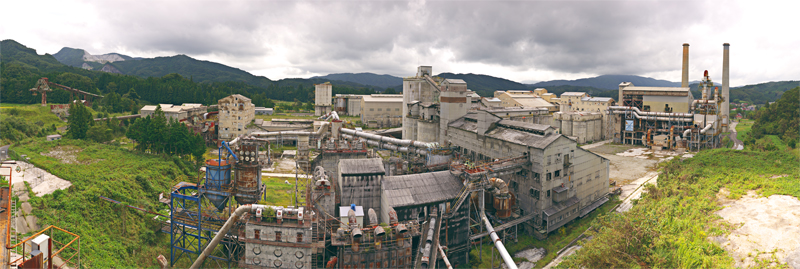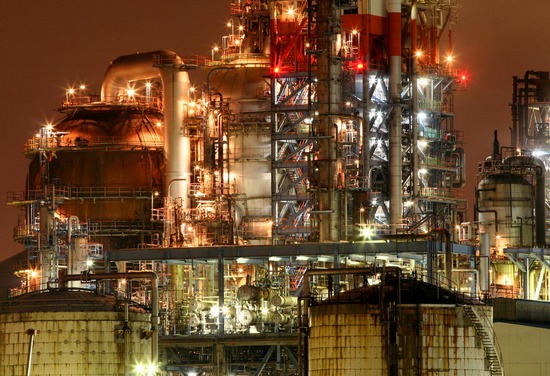koujou moe 工場緒え le romantisme des usines
INDUSTRIAL AESTHETICS/THe Japan Times:
Beauty beheld in brutalism
By TOMOKO OTAKE
Staff writer
No matter how wild or wacky their hobbies or obsessions, in the age of the Internet no one need feel isolated any more, and by casting all inhibitions aside almost anyone is assured of finding like-minded others out there in cyberspace — if not just around the corner from home.
 |
| Beauty in the brutalism of functional industrial construction is well represented by this nighttime shot of a petrochemical plant in the waterfront Honmoku district of Yokohama (above), while smoke billowing from a huge chemical complex in Yokkaichi, Mie Prefecture (below), adds an ethereal touch to an otherwise entirely mechanistic scene. TETSU ISHII PHOTOS |
 |
Tetsu Ishii is no exception. Through the Web, the freelance illustrator from Tokyo's residential Suginami Ward has astonishingly found thousands of men and women, young and old, who all share the same passion as him: they love factories.
Factories? Those lifeless, air-polluting, giant metallic structures? How could factories be attractive to anyone?
But according to Ishii, who heads an 8,000-plus-member mixi (social networking) Web community titled "Kojo Kombinato Ni Moeru Kai (A Group in Love With Factories and Industrial Complexes)," those gargantuan, steam-spewing constructions have an aesthetic all their own.
"Factories represent functional beauty on a scale that is never seen in other structures," Ishii, 40, explains at a cafe in Tokyo's Akihabara district, which is known as the nation's mecca for all things "geeky."
To date, Ishii has visited dozens of industrial plants around the country to capture their majestic beauty with his camera at various times of the day and seasons of the year.
Whether his viewfinder is filled with the long evening shadows cast by a gigantic, steam-belching petrochemical complex, or ocean-front gas-storage tanks lit up surreally against the sea and a dark night sky, Ishii is in awe of them all.
Finally, in March, Ishii's hobby turned into a photo book titled "Kojo Moe (Factory Love)," which features his images of gargantuan steel plants, towering oil refineries and chemical factories billowing clouds of who knows what.
The book has sold more than 30,000 copies, which is unprecedented for its genre, according to the publisher, Tokyo Shoseki Co. Ltd.
Ishii says the roots of his infatuation lie in science fiction, which often features factories in the backgrounds of futuristic films, manga and anime.
While he was long vaguely aware of his love for these cathedrals of industry, he says it was not until his teenage years that he clearly acknowledged his own deep feelings.
"I was watching 'Blade Runner,' " this native of Ikeda City, Osaka, recalls, referring to the 1982 movie starring Harrison Ford. "It's set in a gloomy future Los Angeles, and the lead character has a flying patrol car. I was glued to the city's metallic landscape — I found it so beautiful."
After high school, Ishii went to work in Tokyo. Soon afterward, he says, he was naturally drawn to places in and around the metropolis where he could view petrochemical complexes and huge industrial sites. At such venues, Ishii would spend hours marveling at the way they kept working throughout the night, with their bright lights on. Yet for years, he says, it was hard for him to express his feelings to others, let alone share them.
That changed, however, when he found a handful of like-minded souls who had written about their fascination with factories on the Web, and he met up with them several years ago.
 |
| Factories fan Tetsu Ishii, who heads a Web community with some 8,000 members who behold beauty in sights most consider eyesores. TOMOKO OTAKE PHOTO |
"It was winter, and we organized a tour of factories in the Kawasaki area (of Kanagawa Prefecture)," he says. "Until then, I had thought there might be something wrong with me, for feeling so excited about factories. But then when I met face to face with these people, I discovered that they were even more deeply in love with factories! I felt relieved."
Ishii says that everyone has a different reason for being attracted to factories, noting that some do feel sexually turned on by the metal creations, what with all those thrusting columns and sinuous pipes. Ishii, though, insists he finds "zero sexual appeal" in them, even though his book's title contains the word "moe" — a word that Akihabara wanderers started to use a few years ago to express their romantic feelings for costumed "maids" and young female characters in anime and comics.
Ishii says he put "moe" in the title simply because he wanted the book to appeal not just to photo geeks or industry experts, but to ordinary people as well. Others he knows personally who regularly gathered to view factories, Ishii says, include academics who are researching ways to narrow the gap between industry and citizens, artists fascinated by their complex forms, and those who actually work in them and love the atmosphere.
For freelance writer/photographer Ken Oyama, however, it is a feeling of nostalgia that draws him back again and again to factories.
 |
| Whether they are seen by night, like this oil refinery in Yokohama's Negishi district (above), or in broad daylight, such as this huge complex in the Ukishima district of Kawasaki, massive industrial plants are things of great "functional beauty" for the many people with eyes to see them that way. TETSU ISHII PHOTOS |
 |
Oyama, who spent his childhood in Funabashi, Chiba Prefecture, says that he has many fond memories of going on bicycle rides with his father to the industrial area in his neighborhood. Oyama says he wants to resist the "fixed thinking" in society which has it that people can only be moved by rural landscapes or nice-looking streets. "There is nothing wrong with feeling nostalgic for factories," he says. "It's no different from being touched by the sight of the setting sun."
But don't these factory freaks have any reservations about expressing their attraction to something with a dark side to it? After all, Japan is widely known as a birthplace of kogai (industry pollution), with polluted air and water from factories having caused tremendous health damage to people living nearby from the 1950s through the 1970s — even killing some and causing life-changing disabilities to other adults, babies and fetuses.
While he acknowledges that his group has yet to attract self-proclaimed "eco-friendly" types, Ishii says that people should learn more about factories, whether they love them or hate them.
"Eco-friendly people care a lot about food and where it comes from. But we hardly ever think about how our lives are tied to factories," he says.
"However, we should not shun factories, because shunning them makes it even more difficult for us to understand what is happening in our society."
Tetsu Ishii and Ken Oyama will co-host "Kojo Night," a talk show/slide show on images of factories, showcasing some of their photos, from 4 p.m. on Aug. 25 at Tokyo Culture Culture in Odaiba (nearest station Aomi on the Yurikamome Line). Admission is ¥1,500. For more information, visit tcc.nifty.com
The Japan Times: Sunday, Aug. 19, 2007
(C) All rights reserved
blog a consulter:
http://blog.livedoor.jp/sohsai/archives/cat_59739.html
reflexion:
le romantisme de l'aire moderne, de ses usines ou de nos sentiments d'envie, de revanche et de competitivite intellectuelle et politique, sur des constructions de cette epoque, les buildings et sky-scrapers, avec leur batis et leurs ouvriers, montrent que la competitions industrielles des lumieres et des villes exposantes, les cites des expositions universelles, marquent la permanence du colonialisme industrielle jusqu'a nos jours. La suprematie du bati est toujours a l'oeuvre dans le challenge de "la tour la plus haute du monde" et dans ses epurations ethnico-economique des "slums/bidonvilles" lors de visite officielles, de plan de remodualtion economique ou encore de jeux olympiques. Les enjeux et les exclusions sont des les pile et face de cette meme medaille.
Au dela de son angoumant politique et corporation industrielle de pouvoir, positionnement acquis de ce processus moderne, les positonnant strategiquement en haut de la pyramide socio-economique, des forces du travail egalement, ces paradigmes gagnent les coeurs paiens et populaires, comme au temps de baudelaire, verhaeren, rousseau, munch, manet... ou on peignait la ville comme un monstre devoreur de la terreur et de la vie humaine populaire. Le nombre d'attirance vers le urban landscape, les banlieues, les usines desfectees, les villes pauvres, sont une continuite de ce sentiment populaire moderne des classes "absorbees" par ses pheneomenes ambivalents de course en avant et de regain d'inegalites inhumaines. Avec comme point contemporain, le sentiment "desafecte" ou "la depolitisation", comme une nostalgie du perdant... l'explosion urbaine dans les nouveaux pays industrialises naissent avec un paradigme renversant: les bidonvilles deviennent la forme "informelle" majoritaire dans les nouvelles megapoles, notamment indiennes et sub-sahariennes. Ils destabilisent les references urbaines en termes de classes ou de sociologie urbaine. Les reseaux d'entre aide de la misere s'effritent dans une surexploitation des uns des des autres, des conditions de competition innommables, surtout des femmes, des enfants et des diminues, avec comme recourt communautaire le regain de communaute magiques ou mafieuses, et des sectes, avec la condamnation des enfants sorciers. Dans les pays dits riches, les banlieux et les les populations stigmatisees, souvent migrantes, cumulent difficultes socio economique, de logement et de diabolisation mediatique. Les jeunes se tournent aussi vers des organisations a tendances religieuse, mafieuse, narcoleptiques ou terroristes. Partout on voit naitre une criminalisation et/ou precarisation des jeunes et des personnes agees. Partout on voit les sentiments de devalorisation morale ou ethnographique des enfants et des jeunes, et de la diabolisation voire de l'auto-diabolisation clanique des pauvres pour regir et inter agir dans des relations conflictuelles de reseaux (guerres des gans, guerres des quartiers ou des banlieues, guerres des brand industrielles de reconnaissance).
Les edges cities et les reseaux d'infrastructures assimiles leur antipodes sementiques, copies pastiches d'une floride ou d'un new york (chine, singapour, hong Kong, Tokyo, seoul, ou dans les emirats(dubai).
Serait-ce le debut du temoignage historique populaire de la passe de ce modele urbain dominant?
Ou alors d'une redistribution sur l'echiquier mondial (decentralisation, poperisation des campagnes, des banlieues) qui n'anoncerait alors pas son epuisement, mais son apocalyptique essor?
Certains experts previsualisent les megabidonvilles de l'informalite comme une nouvelle urbanite du XXI eme siecle avec de nouvelles economies d'echanges, il decrivent deja des conditions depassant deja les epoques victoriennes, les naples, les londres et les paris miseeux d'autrefois.





/http%3A%2F%2Fcdn.els-cdn.com%2Fsd%2Fentities%2FREcor.gif)
/http%3A%2F%2Fwww.australiangeographic.com.au%2Fassets%2Fimages%2Farticle%2Fjournal%2F11201%2Fplants-can-talk.jpg)
/https%3A%2F%2Fstorage.canalblog.com%2F98%2F86%2F144630%2F65963506_o.jpg)
/https%3A%2F%2Fstorage.canalblog.com%2F50%2F20%2F144630%2F65963106_o.jpg)
/https%3A%2F%2Fprofilepics.canalblog.com%2Fprofilepics%2F1%2F2%2F121690.jpg)
/https%3A%2F%2Fstorage.canalblog.com%2F77%2F74%2F144630%2F14862517_o.jpg)
/https%3A%2F%2Fstorage.canalblog.com%2F21%2F20%2F144630%2F14838698_o.jpg)
/https%3A%2F%2Fstorage.canalblog.com%2F59%2F56%2F144630%2F14833026_o.jpg)
/https%3A%2F%2Fstorage.canalblog.com%2F27%2F46%2F144630%2F14833014_o.jpg)
/https%3A%2F%2Fstorage.canalblog.com%2F83%2F53%2F144630%2F14833023_o.jpg)